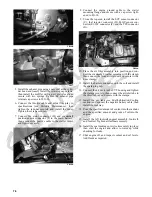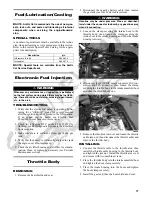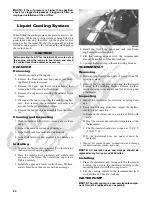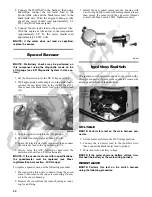
85
Electrical System
NOTE: Certain components and sensors can be
checked by using the EFI diagnostic system and digi-
tal gauge (see EFI Diagnostic System in this section
for more information).
This section has been organized into sub-sections which
show procedures for the complete servicing of the Arctic
Cat ATV electrical system.
SPECIAL TOOLS
A number of special tools must be available to the techni-
cian when performing service procedures in this section.
Refer to the current Special Tools Catalog for the appro-
priate tool description.
NOTE: Special tools are available from the Arctic
Cat Service Department.
Electrical Connections
The electrical connections should be checked
periodically for proper function. In case of an electrical
failure, check fuses, connections (for tightness,
corrosion, damage), and/or bulbs.
Testing Electrical Components
All of the electrical tests should be made using the Fluke
Model 73 Multimeter or Fluke Model 77 Multimeter and
when testing peak voltage, the Peak Voltage Reading
Adapter must be used. If any other type of meter is used,
readings may vary due to internal circuitry. When trou-
bleshooting a specific component, always verify first that
the fuse(s) are good, that the bulb(s) are good, that the
connections are clean and tight, that the battery is fully
charged, and that all appropriate switches are activated.
NOTE: For test accuracy, all tests should be made
at room temperature approximately 68° F.
Battery
NOTE: Preliminary checks may be performed on
this component using the diagnostic mode on the
LCD gauge (see EFI Diagnostic System in this sec-
tion)
The battery is located under the seat.
After being in service, batteries require regular cleaning
and recharging in order to deliver peak performance and
maximum service life. The following procedure is rec-
ommended for cleaning and maintaining a sealed battery.
Always read and follow instructions provided with bat-
tery chargers and battery products.
NOTE: Refer to all warnings and cautions provided
with the battery or battery maintainer/charger.
Loss of battery charge may be caused by ambient temper-
ature, ignition OFF current draw, corroded terminals, self
discharge, frequent start/stops, and short engine run
times. Frequent winch usage, snowplowing, extended
low RPM operation, short trips, and high amperage
accessory usage are also reasons for battery discharge.
Maintenance Charging
NOTE: Arctic Cat recommends the use of the CTEK
Multi US 800 or the CTEK Multi US 3300 for battery
maintenance charging. Maintenance charging is
required on all batteries not used for more than two
weeks or as required by battery drain.
800E
1. When charging a battery in the vehicle, be sure the
ignition switch is in the OFF position.
2. Clean the battery terminals with a solution of baking
soda and water.
NOTE: The sealing strip should NOT be removed
and NO fluid should be added.
3. Be sure the charger and battery are in a well-venti-
lated area. Be sure the charger is unplugged from the
110-volt electrical outlet.
4. Connect the red terminal lead from the charger to the
positive terminal of the battery; then connect the
black terminal lead of the charger to the negative ter-
minal of the battery.
NOTE: Optional battery charging adapters are avail-
able from your authorized Arctic Cat dealer to con-
nect directly to your vehicle from the recommended
chargers to simplify the maintenance charging pro-
cess. Check with your authorized Arctic Cat dealer
for proper installation of these charging adapter con-
nectors.
5. Plug the battery charger into a 110-volt electrical
outlet.
Description
p/n
Fluke Model 73 Multimeter
0644-191
Fluke Model 77 Multimeter
0644-559
MaxiClips
0744-041
Peak Voltage Reading Adapter
0644-307
















































